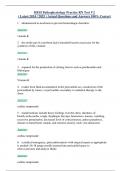HESI Pathophysiology Practice RN Test V2
( Latest ) Actual Questions and Answers 100% Correct
1. administered to newborns to prevent hemorrhagic disorders:
Answer:
vitamin K
2. the sterile gut of a newborn lacks intestinal bacteria necessary for the
synthesis of this vitamin:
Answer:
vitamin K
3. required for the production of clotting factors such as prothrombin and
fibrinogen:
Answer:
Vitamin K
4. results from fluid accumulation in the pericardial sac, constriction of the
pericardium by tumor, or pericarditis secondary to radiation therapy to the
chest:
Answer:
cardiac tamponade
5. manifestations include heavy feelings over the chest, shortness of
breath, tachycardia, cough, dysphagia, hiccups, hoarseness, nausea, vomiting,
excessive perspiration, decreased level of consciousness, pulses paradoxes,
distant or muted heart sounds, and extreme anxiety, neck vein distension:
Answer:
cardiac tamponade
6. a medical emergency; pericardiocentesis with surgical repair as appropriate
is needed (16-18 gauge needle inserted into pericardial space to
relieve pressure and analyze fluid):
Answer:
cardiac tamponade
,7. states that, to a point, the more myocardial fibers are stretched, the
greater their force of contraction:
Answer:
Frank Starling's Law
8. is increased with exercise:
Answer:
HDL levels
9. the "good" lipoprotein; has a low lipid content and is used to transport
cholesterol AWAY from the peripheral cells to the liver, where it undergoes
catabolism and excretion:
Answer:
HDL
10. protects women until after menopause:
Answer:
HDL
11. decreases HDL levels:
Answer:
Smoking
12. indicative of angina pectoris; condition in which the heart has outgrown
its blood supply:
Answer:
Hypertrophy
13. right ventricular hypertrophy occurs in this condition:
Answer:
Tetralogy of Fallot
14. can lead to ventricular hypertrophy;
,Answer:
afterload, hypertension
15. an increase in the muscle mass and cardiac wall thickness in response
to overwork and strain; occurs slowly because it takes time for increased
muscle tissues to develop; generally follows persistent or chronic dilation
and thus further increases the contractile power of the muscle fibers:
Answer:
Hypertrophy
16. will lead to an increase in CO and maintenance of tissue perfusion:
Answer:
Hypertrophy
17. used when heart failure occurs:
Answer:
intraaortic balloon pump therapy
18. necessary when drugs have failed; is a short term bridge to cardiac
transplantation; needed if acute myocardial infarction occurs with ventricular
aneurysm accompanied by ventricular dysrhythmias, acute ventricular
septal defect, acute mitral valve dysfunction, cardiogenic shock, or refractory
chest pain with or without ventricular dysrhythmias:
Answer:
intraaortic balloon
pump therapy
19.when maintained well, maintains skin and mucous membranes and is also
essential in reducing host susceptibility:
Answer:
Nutrition
20. pts with advanced cancer are often _:
Answer:
Malnourished
, 21. involves the administration of a nutrient mixture directly into a
peripheralvein:
Answer:
total parenteral nutrition
22. asymptomatic disease with mild discomfort, diarrhea, or constipation
andflatulence which can be excused for other reasons:
Answer:
Diverticulosis
23. during acute episodes, food intake should be reduced along with
antimicrobialdrugs taken as needed; treated by increasing the bulk in the diet,
omitting foods such as seeds or popcorn, and encouraging regular bowel
movements without constipation:
Answer:
Diverticulosis
24. includes the pituitary gland, the two adrenal glands, the thyroid gland,
thefour parathyroid glands, the endocrine portion of the pancreas, the
gonads, the pineal gland, and the thymus:
Answer:
endocrine glands
25. secrete hormones directly into the blood, in contrast to exocrine
glandsthat secrete into a duct:
Answer:
endocrine glands
26. chemical messengers that affect blood glucose levels, including
insulin,glucagon, epinephrine, cortisol, and growth hormone:
Answer:
Hormones
27. develops more frequently in patients with Type 2 diabetes; often the
patientis an older person with an infection or one who has overindulged in
carbs, thereby using more insulin than anticipated:




